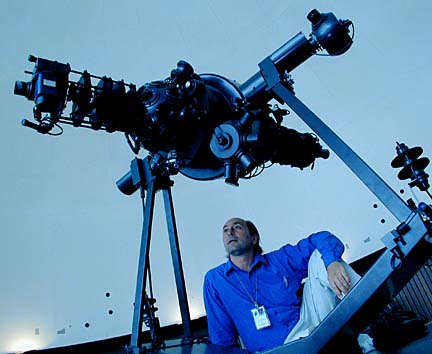Advertisement - Click to support our sponsors.


Planetarium shows
By Burl Burlingame
have a great
‘wow!’ factor
Star-BulletinNothing quite puts you in your place like staring up into that vast bowl of starry night and realizing that you are only a microscopic speck on a tiny mote in an insignificant subdivision of a two-bit solar system on the farthest fringes of a faraway galaxy lost in the howling abyss of deepest space. The universe is not only bigger and stranger than we can comprehend, it's bigger and stranger than we CAN comprehend.
Explains why we look at our shoes when we walk.
Nonetheless, the ability to enjoy the night sky is largely lost these days, vanished thanks to cloud cover, haze, sedentary lifestyles and urban light pollution. That makes the planetarium shows at Bishop Museum so cool to experience. And they're even cooler these days, thanks to brand-new equipment recently installed.
"There is an emotional and intellectual connection to the night-time sky that goes right beyond the rules of natural science and appeals directly to the heart," said Mike Shanahan, the museum's "Planetarium Producer."
"One of the really neat things is when kids say wow! when they see -- really see -- the night sky for the first time. They don't have any idea what to expect. With adults, they often have fond memories of the night sky from some -- ahem -- event in their past."
The original planetarium projector was first fired up on Dec. 12, 1961, and worked right up 'til now. "It was a Spitz unit, from Pennsylvania," said Shanahan. "There are really only four planetarium-equipment manufacturers -- Spitz in the U.S.; Zeiss in Germany; Minolta and Goto in Japan."
The new unit is a Goto, and no, you can't have the old planetarium projector. It was traded in.
Planetarium projectors are essentially globes with a bright light inside. They have precisely milled holes and tubes that project the light in tiny spots on the inside of a hemispherical screen on the ceiling. This "star ball" contraption is the single best way of conveying the intricacies of the night sky in three dimensions, and it's controlled by motors to rotate and move up and down, showing their sky anywhere on Earth.
"There is a a computer-projection system call DigiStar, but it's not sharp or convincing enough," said Shanahan. "But you can show what the stars look like from another planet, though, and that can be handy."
The first planetariums were actually globe-shaped rooms with holes punched the walls to replicate the stars. "Then early in this century they started using the star ball, pinhole idea, and planetariums became very popular. There are something like 5,000 planetaria worldwide. The star balls are different sizes and wattages depending on the size of the room."
The unit also contains geared movements for the planets and moons, projectors of the constellations, and a bank of controls that appear to be off the Starship Enterprise (the 1960s version).
"Ours uses a halogen bulb, which is great, because the old model had a specialized light source that cost $400 to replace every time the bulb burnt out."
A unit like the Bishop Museum's new projector can cost as much as $200,000, "depending on the bells and whistles, the basics and features," said Shanahan. "It's kind of like buying a new car; The basics are there, and then you decide -- more constellations? More slide projectors around the base? Azimuth and declination?"
This also means that the new equipment won't be used in the museum's upcoming Science Center, which will feature a larger, swanker planetarium.
A planetarium loaded with features, "top of the line," can cost a couple of million. "We're talking 6,000 or 7,000 stars! Panoramas! Constellations galore! Gears that take us back to Chaucer's time or 2,000 years in the future! We're not at that stage yet."
One thing Honolulu requires, though, is a double-star ball arrangement so that stars of the southern hemisphere can also be shown. "It not like we're in Seattle or Argentina, here we need both. Imagine the difficulty Nainoa Thompson would have had memorizing the night sky, night after night here in the planetarium, without being able to see the stars below the equator."
As Shanahan is explaining things, the lights in the upper part of the planetarium come on, behind the hemispheric screen, and we're surprised to see there is a fair amount of room between the ceiling and the screen. There are also a couple of buckets hanging in mid-air, somewhere beyond the constellations of Andromeda and Cassiopeia.
"Uh, the roof leaks," said Shanahan. "It's an old building."
New planetarium show, produced in partnership with NASA: 'Explorers of Mauna Kea'
Place: Bishop Museum
Admission: $14.95 non-residents; $11.95 non-resident children 4 to 14. Hawaii-resident, military and seniors pay $7.95; resident children, $6.95.
Call: 847-3511
Click for online
calendars and events.